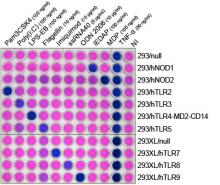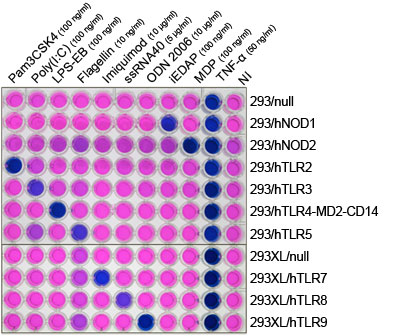293/TLR9
| Product | Unit size | Cat. code | Docs. | Price | |
|---|---|---|---|---|---|
|
293XL/hTLR9 293XL cell line expressing the human TLR9a gene |
Show product |
3-7 x 10e6 cells |
293xl-htlr9
|
||
|
293/mTLR9 293 cell line expressing the murine TLR9 gene |
Show product |
3-7 x 10e6 cells |
293-mtlr9
|
HEK293 clones expressing TLR9
293/mTLR9 cells were obtained by stable transfection of HEK293 cells with a pUNO-TLR9 plasmid which expresses the murine TLR9 gene.
293XL/TLR9A cells were obtained by stable transfection of HEK293XL cells with a pUNO-TLR9 plasmid which expresses the human TLR9 gene.
The control cell line of 293/mTLR9 cells is 293/null.
The control cell line of 293XL/hTLR9A cells is 293XL/null cells.
Back to the top
Specifications
Antibiotic resistance: blasticidin
Growth medium: DMEM, 4.5 g/l glucose, 2-4 mM L-glutamine, 10% (v/v) fetal bovine serum, 50 U/ml penicillin, 50 μg/ml streptomycin, 100 μg/ml Normocin™
Guaranteed mycoplasma-free
These products are covered by a Limited Use License (See Terms and Conditions).
Back to the topContents
- 1 vial containing 3-7 x 106 cells
- 100 μl Blasticidin (10 mg/ml)
- 1 ml Normocin™ (50 mg/ml)
![]() Shipped on dry ice (Europe, USA, Canada and some areas in Asia)
Shipped on dry ice (Europe, USA, Canada and some areas in Asia)
Description
TLR9 is expressed in the endoplasmic reticulum of resting cells in contrast to most TLRs that are located on the plasma membrane [1]. TLR9 recognizes specific unmethylated CpG-ODN sequences, that distinguish bacterial DNA from mammalian DNA. TLR9 engages an intracellular signaling pathway that involves MyD88 leading to NF-κB translocation [2]. TLR9 recognizes different CpG motifs; the optimal sequences being GTCGTT and GACGTT for human TLR9 and murine TLR9 respectively [3]. TLR9 binds directly to CpG DNA and recognizes specifically CpG DNA that is unmethylated and single stranded [4].
1. Latz E. et al., 2004. TLR9 signals after translocating from the ER to CpG DNA in the lysosome. Nat Immunol. 5(2):190-8.
2. Chuang TH. et al., 2002. Toll-like receptor 9 mediates CpG-DNA signaling. J Leukoc Biol, 71(3):538-44.
3. Bauer S. et al., 2001. Human TLR9 confers responsiveness to bacterial DNA via species-specific CpG motif recognition. Proc Natl Acad Sci USA, 98(16):9237-42.
4. Rutz M. et al., 2004. Toll-like receptor 9 binds single-stranded CpGDNA in a sequence- and pH-dependent manner. Eur J Immunol. 34(9):2541-50.






